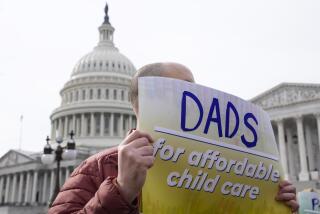Editorial: Child care is in crisis, but we can fix it — and help the economy, too

- Share via
Our pandemic-stricken society cheered the brave first-responders and medical crews who confronted COVID-19 risks every day, thanked grocery workers and tipped delivery people extra (you did, didn’t you?). But one group of essential workers went almost unnoticed: The child-care providers who made it possible for those essential workers to keep things running.
This generally low-paid industry took hits in every way. Demand and revenue plummeted while safety-related expenses raised costs. Caregivers who stayed open sometimes couldn’t find enough employees because of fears of infection, and other times, those who worked were indeed infected. Meanwhile, 1 in 4 women who became unemployed during the pandemic were put in that position not because of lack of jobs but because they couldn’t find child care.
COVID-19 not only put the industry under unprecedented strain, it also exposed deep fissures that have been largely ignored for decades. Lack of quality, affordable day care has strained families, held women back in the workforce and robbed the economy of their contributions. Long before children reach preschool age, their experiences are shaping their future successes or struggles in school and beyond, yet we have been neglecting this crucial phase of their lives, when brains are developing at a rapid pace.
The pandemic worsened it all. By the end of 2020, there were about 167,000 fewer child-care workers than the year before, a drop of about 14%, because centers reduced capacity or closed altogether. Day-care enrollment fell by about half in California and other states, a UC Berkeley survey revealed.
Now workplaces are opening up, employees are being ordered back to the classroom or the office or other workplaces, and demand for child care is growing fast. But the spots aren’t there to meet the need, and prices have risen because of scarcity and increased costs.
And guess what? The country was millions of spots short even before the pandemic. Nearly a third of the children in need of child care went without it; their parents relied on a patchwork of family and friends for help, sometimes working fewer hours as a result. Usually, it was the mother who stayed home.
The U.S. has been moving too slowly to provide preschool for all the children who need it, even though preschool is known to help prepare children for their earliest years of formal education. And universal preschool isn’t enough; research has shown that the size of a child’s vocabulary by age 2 — long before preschool starts — predicts how that child will fare in kindergarten and beyond. The right mix of stimulation, play and nurturance during this early time is proving far more influential than previously thought.
Developing a more comprehensive and user-friendly child-care system, one that pays special attention to financially strapped families, will take investment, but it will be recouped in part through reductions in other costs — public assistance for women who now are kept from the job market, social-welfare expenses for distressed families — as well as increased tax revenue from women freed to earn more. That, at least, has been the experience in Canada’s Quebec province.
The crisis in affordable child care came to a head locally this month when United Teachers Los Angeles, in an agreement that brings teachers back to L.A. Unified campuses, negotiated a day-care stipend. Teachers with children ages 5 and younger will receive $500 per month for each kid to help defray the cost.
It’s not that teachers deserve this help more than other essential workers such as nurses, farmworkers and the like. But the question shouldn’t be, “Why do teachers get this benefit?” It should be, “Why doesn’t this country do a better job on this for all workers who need it?”
In Quebec and in many European nations, high-quality child care is heavily subsidized by the government; in some countries, such as France, it’s free starting with infants, but there’s a steep shortage of openings and long waiting lists. In England, middle-class parents pay a higher percentage of their incomes than Americans do. In fact, it’s the most expensive day-care system in the world. But targeted subsidies bring the cost way down for impoverished British families, while in the U.S., a low-income single mother of two children pays close to a third of her income for day care.
The $1.9-trillion COVID-19 relief bill enacted in March includes nearly $39 billion to keep existing child care operations in business and allow the shuttered ones to reopen, as well as subsidize child care for essential workers. It also nearly triples the tax credit for child care, with the benefits tilted toward lower-income families. But these are one-time measures that won’t fix the systemic shortage of quality, affordable child care. The government must build capacity, using the existing system as a base and partnering with the private sector to make day-care centers in workplaces common, increasing the number of independent providers and creating a sustainable funding source for child care subsidies.
California provides vouchers for child care to help parents move from welfare to work, but many parents who already have jobs can’t afford day care. Partial subsidies are needed to help keep women in the workforce, and should be available not just to licensed providers but to relatives such as grandparents who do the babysitting, just as Medi-Cal allows relatives to be paid for providing elder care.
At the same time, wages for day-care workers need to increase, in order to draw more people to the field. Higher pay will raise the cost of care (and the cost of the subsidies), but it’s crucial to reducing the shortage of slots.
Americans are generally aware that the nation needs a more educated population to spread prosperity and compete in the global economy. Instead of defining that solely in terms of who goes to college, however, we need to think more about nurturing the rapid brain development of very early childhood, taking the strain off families and making it possible for more women to enter the labor force and contribute to the nation’s wealth.
More to Read
A cure for the common opinion
Get thought-provoking perspectives with our weekly newsletter.
You may occasionally receive promotional content from the Los Angeles Times.










